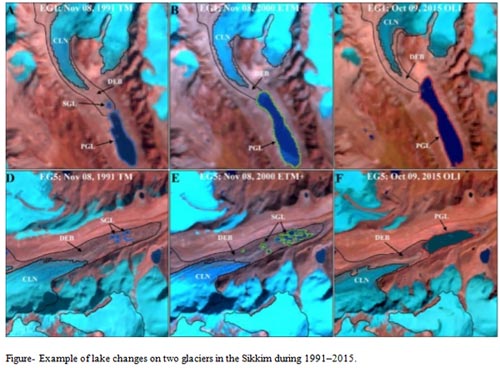 Scientists from Wadia Institute of Himalayan Geology (WIHG), Dehradun an autonomous research institute for the study of Geology of the Himalaya under the Department of Science and Technology, have found that glaciers in Sikkim are melting at a higher magnitude as compared to other Himalayan regions.
Scientists from Wadia Institute of Himalayan Geology (WIHG), Dehradun an autonomous research institute for the study of Geology of the Himalaya under the Department of Science and Technology, have found that glaciers in Sikkim are melting at a higher magnitude as compared to other Himalayan regions.
The study published in Science of the Total Environment assessed the response of 23 glaciers of Sikkim to climate change for the period of 1991-2015 and revealed that glaciers in Sikkim have retreated and deglaciated significantly from 1991 to 2015. Small-sized glaciers in Sikkim are retreating while larger glaciers are thinning due to climate change.
To understand the various parameters of Sikkim Himalayas glaciers such as length, area, debris cover, snow-line altitude (SLA), and how they respond to global warming Scientists from WIHG selected 23 representative glaciers from this region. A detailed and rigorous literature survey related to the study was carried out to assess the existing knowledge in the subject. Thereafter, representative glaciers well spread over the study area were selected based on multiple criteria such as size, length, debris cover, slope, aspect, and so on. Then, the multi-temporal and multi-sensor satellite data covering selected glaciers was procured. The team analyzed the results and compared with existing studies, and the impact of various influencing factors was systematically explored to understand the glaciers state.
The behavior of glaciers in the region is heterogeneous and found to be primarily determined by glacier size, debris cover, and glacial lakes. Though a generalized mass loss is observed for both small (less than 3 km square) and large-sized glaciers (greater than 10 km square), they seem to adopt different mechanisms to cope with the ongoing climatic changes. While the first adjust mostly by deglaciation, the latter lose mass through down wasting or thinning.
The Sikkim glaciers have been poorly studied till now, and field-based mass balance measurements have been limited to only one glacier (Changme Khangpu) and for a short period (1980-1987). The studies are regional in nature and do no give emphasis on individual glacier behavior. Besides, most of the existing measurements in this region have been focused on length/area changes only. Velocity estimations have also been extremely rare.
This study, for the first time, studied multiple glacier parameters, namely length, area, debris cover, snowline altitude (SLA), glacial lakes, velocity, and down wasting, and explored interlinkage among them to present a clear picture about status and behavior of glaciers in the Sikkim.
Accurate knowledge of magnitude as well as the direction of glacier changes, as highlighted in the present study, can lead to awareness among common people regarding water supplies and possible glacier hazards, particularly to those communities that are living in close proximity. The study can provide ample baseline data on glacier changes and systematically explore the causal relationship between glacier parameters and various influencing factors. A clear understanding of glacier state will help orienting future studies as well as taking necessary measures.






























